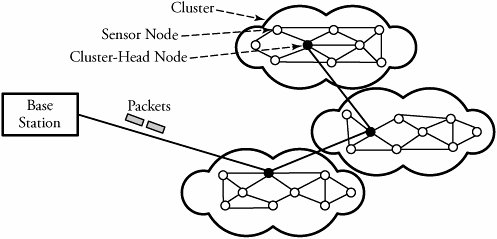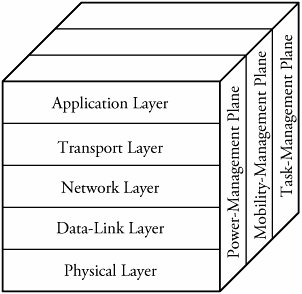Section 20.1. Sensor Networks and Protocol Structures
20.1. Sensor Networks and Protocol StructuresChemical, biological, or solar sensors can be networked together as a sensor network to strengthen the power of sensing. A sensor network is controlled through a software core engine. The network is typically wireless but may also be wired. Sensor networks are designed to be self-configuring such that they can gather information about a large geographical area or about movements of an object for surveillance purposes. Sensor networks can be used for target tracking, environmental monitoring, system control, and chemical or biological detection. In military applications, sensor networks can enable soldiers to see around corners and to detect chemical and biological weapons long before they get close enough to cause harm. Civilian uses include environmental monitoring, traffic control, and providing health care monitoring for the elderly while allowing them more freedom to move about. 20.1.1. Clustering in Sensor NetworksThe region being sensed is normally partitioned into equally loaded clusters of sensor nodes, as shown in Figure 20.1. A cluster in a sensor network resembles a domain in a computer network. In other words, nodes are inserted in the vicinity of a certain predefined region, forming a cluster. Different types of sensors can also be deployed in a region. Thus, a sensor network is typically cluster based and has irregular topology. The most effective routing scheme in sensor networks is normally based on the energy (battery level) of nodes. In such routing schemes, the best path has the highest amount of total energy. The network of such sensing nodes is constructed with identical sensor nodes, regardless of the size of the network. In Figure 20.1, three clusters are interconnected to the main base station, each cluster contains a cluster head responsible for routing data from its corresponding cluster to a base station . Figure 20.1. A sensor network and its clusters Communicating nodes are normally linked by a wireless medium, such as radio. The wireless sensor node is equipped with a limited power source, such as a battery or even a solar cell , where there is enough sunlight exposure on the node. However, a solar cell may not be the best choice as a power supply, owing to its weight, volume, and expense. In some application scenarios, sensor-node lifetime depends on the battery lifetime. Removal of dead nodes can cause significant topological changes and may require packet rerouting. As a result, power management is a key issue in system design, node design, and communication protocol development. In summary, efficient energy-conscious clustering and routing algorithms can potentially prolong the network lifetime. 20.1.2. Protocol StackThe algorithms developed for wireless ad-hoc networks cannot be used for sensor networks, for several reasons. One is that the number of sensor nodes is typically much more than in a typical ad-hoc network, and sensor nodes, unlike ad-hoc nodes, are prone to permanent failure. In addition, sensor nodes normally use broadcast rather than point-to-point communication with its limited power and memory. Unlike computer networks, sensor nodes do not have global ID, since a typical packet overhead can be too large for them. Figure 20.2 shows a protocol architecture for sensor networks. The protocol stack combines power efficiency and least-cost-path routing. This protocol architecture integrates networking protocols and power through the wireless medium and promotes cooperative efforts of sensor nodes. The protocol stack consists of the physical layer, data-link layer, network layer, transport layer, and application layer, backed by a power-management plane, mobility-management plane, and task-management plane. The physical layer is responsible for robust modulation, transmission, and receiving signals. Media access control (MAC) at the data-link layer must minimize packet collision with neighboring nodes, as power is a restricted factor. The network layer routes packets provided by the transport layer. The application layer uses software for preparation of data on an event. The power-management plane monitors the sensor's power level among the sensor nodes and manages the amount of power a sensor node has used. Figure 20.2. Sensor network protocol stack architecture Most of the sensor network routing techniques and sensing tasks require an accurate knowledge of location. Thus, a sensor node commonly has a location-finding system. A mobilizer may sometimes be needed to move sensor nodes to carry out assigned tasks . Sensor network routing protocols must be capable of self-organizing . For these purposes, a series of energy-aware MAC, routing, and clustering protocols have been developed for wireless sensor networks. Most of the energy-aware MAC protocols aim to either adjust the transmission power or keep transceivers off as long as possible . 20.1.3. Sensor Node StructureFigure 20.3 shows a typical sensor node. A node consists mainly of a sensing unit, a processing unit and memory, a self-power unit, and a wireless transceiver component, as well as a self- and remote-testing unit, a synchronizing and timing unit, a routing table, and security units. Since nodes in a network are not physically accessible once they are deployed in the field, they are not worth being brought under test. An option is an on-board remote self-testing unit for the node on a routine basis. Figure 20.3. A typical wireless sensor node Each node must determine its location. This task is carried out by a location-finding system based on the global positioning system (GPS). All the processes within the sensor node are synchronized by a local clocking and synchronizing system. The communication and security protocol units are in fact part of the processing unit. These two units are responsible for computing the best path for networking and security of the data being transmitted. The three main blocks of the sensor nodesensing unit, processing and memory unit, and power unitare described in more detail in the following subsections. Sensing UnitThe sensing unit consists of a sensor and an analog-to-digital converter. A smart sensor node consists of a combination of multiple sensors. The analog signals produced by the sensors, based on the observed event, are converted to digital signals by the converter and then fed into the processing unit. The sensing unit collects data externally and interacts with the central processor at the heart of the node. Processing and Memory UnitThe processing unit performs certain computations on the data and, depending on how it is programmed, may send the resulting information out to the network. The processing unit, which is generally associated with memory, manages the procedures that make the sensor node collaborate with the other nodes to carry out the assigned sensing task. The central processor determines what data needs to be analyzed , stored, or compared with the data stored in memory. The streamed data from the sensor input is processed as it arrives. The database in memory stores an indexed data list to be used as a reference to detect an event. Since sensing nodes are typically tiny and many nodes are engaged in a network, the communication structure makes use of a hierarchically arranged self-routing network through cluster heads. In smart wireless sensor networks, a tiny processor and a tiny database are used in a node. Thousands of such nodes are spread on fields to power up the sensing task, as in the deployment of numerous small intelligent sensor nodes in a battlefield to monitor enemy movements. By inserting self-organizing capability into a sensor network, a smart node can extract data, compare it with the data stored in its memory database, and process it for relevance before relaying it to its central base station. Self-Power UnitA sensor node is supposed to be mounted in a small physical unit, limiting space for the battery. Moreover, the random distribution of sensors makes it impossible to periodically recharge or exchange batteries. In most types of sensor networks, the power unit in a sensor node is the most important unit of the node because the liveliness and existence of a node depend on the energy left in the node, and the routing in the sensor network is based on the algorithm that finds a path with the most energy. Thus, it is essential to use energy-efficient algorithms to prolong the life of sensor networks. The main task of the sensor node is to identify events, to process data, and then to transmit the data. The power of a node is consumed mainly in the transmitter and receiver unit. The sensor node can be supplied by a self-power unit , self-power unitbattery, or solar cells . |
EAN: 2147483647
Pages: 211


